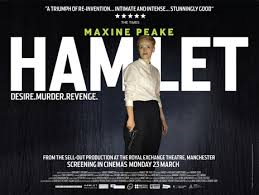
March 28, 2015, by Peter Kirwan
Hamlet (Royal Exchange) @ The Broadway, Nottingham
Watching the Royal Exchange production of Hamlet on the big screen, in a specially recorded film version (still performed in front of an audience, but with a certain amount of editing work to make the most of key images), brought home to me the significance of much of the production’s work. While I enjoyed the original version in the theatre, seeing it up close and personal showed just how much was going on that had been lost when I was sat at a distance and restricted to one side of the in-the-round stage. These are just a few thoughts to supplement my previous review.
- Katie West was an exciting and, far from being passive as I previously suggested, proactive and independent Ophelia. While the production went to great lengths to show how much she was talked over by her father and Claudius (including as she read out the love letters for herself), there was a lot going on behind her eyes revealed in close-up. Early, she teased her brother by sloshing wine around in her glass, threatening to pour it out to illustrate his own hypocrisy; and in the nunnery scene, I was struck by how much physical contact she was prepared to make with Hamlet, sitting on his lap and embracing him. That Hamlet repeatedly drew her in and then thrust her away again made the more poignant her rejection.
- John Shrapnel was a particularly moving Ghost. I noticed more this time how much embracing happens in this production, and the most obvious early example was Hamlet cradling her father as he sobbed, framed beautifully by the production’s hanging lightbulbs.
- The moppets performing the dumb-show were exceptionally cute, but the screaming of the teenage players made even less sense here, kept at a distance and almost invisible in the dark.
- There was really great work in some of the minor roles. Ben Stott seethed with rage as Osric and Tachia Newall was a harsh and tempestuous priest. In a production that was more emotional than any other (and notably, NOT because Hamlet was being played by a female actor), even the smaller roles contributed to the overall palette.
- Placing ‘To be or not to be’ after the death of Polonia gave the speech a very particular purpose, as Hamlet mused on what he had just done while looking at the body. Rather than slow down the action, the speech instead propelled the momentum after the interval as part of the frantic mopping-up after the closet scene.
Finally, publicity around the production implies that this Hamlet, far from being played gender-blind as I previously assumed, is a woman presenting as a man. I remain sceptical that such a reading is obvious from the production itself, but perhaps this is the point – that a princess can choose to live as a prince in a court perfectly happy to accept that choice. Such a reading makes certain moments stand out (most notably, Claudius telling Hamlet that his grief is ‘unmanly’, which seemed deliberately provocative this time) and other moments beautifully ambiguous – Ophelia’s clear love for Hamlet transcended sexual binaries, investing in Hamlet as an individual. But whatever the intended reading, Maxine Peake’s Hamlet was beautifully nuanced, bringing a huge emotional range and childlike tempestuousness to the role.
No comments yet, fill out a comment to be the first

Leave a Reply